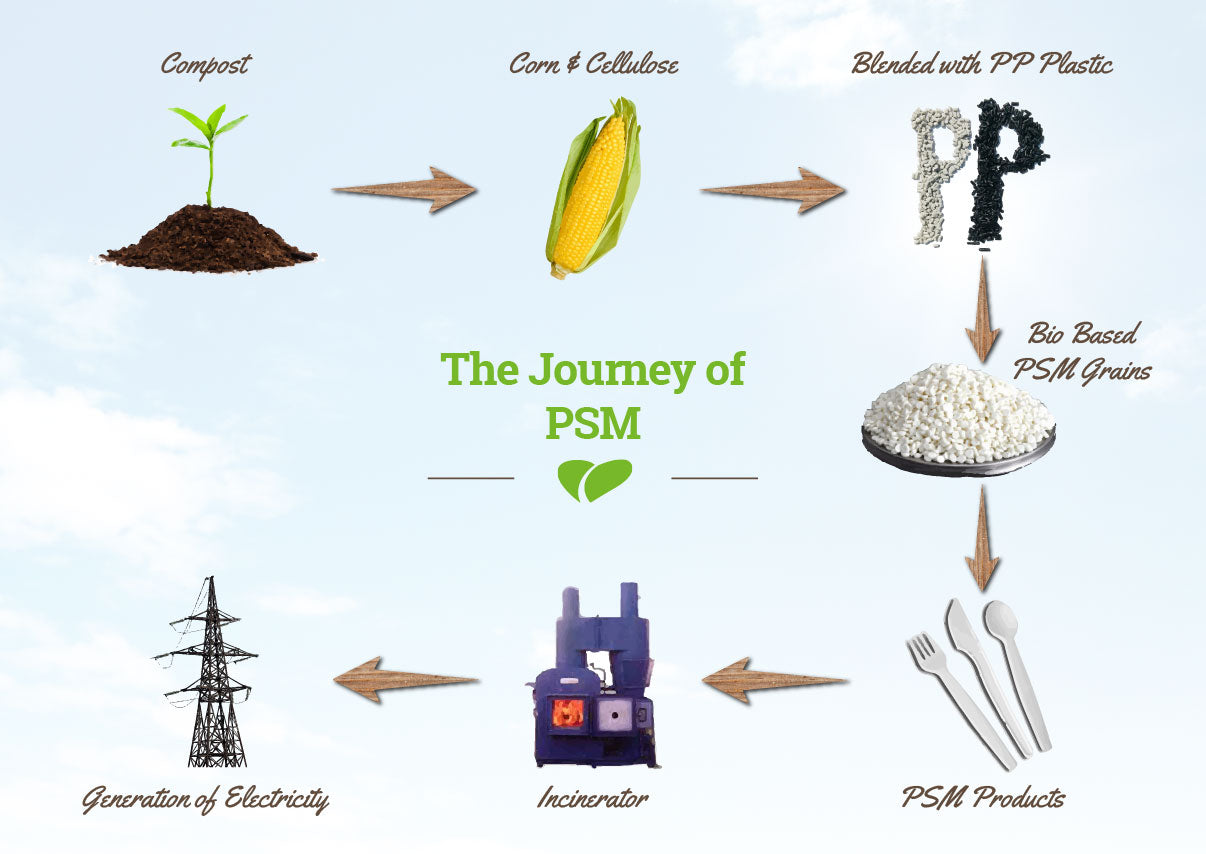Eco Materials
Eco packaging is largely eco because of the materials that are used to make it. As our material life cycles show, most of our materials are renewable so they don't ever have to run out. They typically start life as a plant and can end their lives as compost feeding and enabling new plants to grow.
Sugar Bagasse
Sugar bagasse is a fibrous biodegradable material which comes from the reeds of sugar canes. Bagasse makes an excellent substitute for polystyrene foam which is often used to make conventional fast food takeaway packaging and takes many years to break down.Products made from this sugar cane pulp are not only made from a renewable resource - plants, but are also made from a recycled resource. If sugar bagasse wasn't put to good use and converted into items like food packaging it would just be a WASTE product.
As this life cycle graphic shows, when the bagasse packaging is composted this represents a 'closed loop' as what started off life growing in the soil becomes the soil itself.

Sugar bagasse products can be used in microwaves and refrigerators, are recyclable as well as 100% biodegradable and all of our sugar bagasse tableware and food containers are certified as compostable which means they'll break down in under 12 weeks.
Explore some of our bagasse range here.
PLA
PLA stands for "Polylactic Acid" and is a biodegradable plastic derived from corn starch. This material makes a fantastic alternative to conventional plastics which can take many hundreds of years to break down.Because PLA bioplastic is made from plants which are a renewable resource, by using this bioplastic we are reducing our dependence on finite resources such as petroleum oil.

Compared with conventional plastics which break down over many years into smaller plastic pieces and therefore never truly disappear, when PLA biodegrades it breaks down into organic matter: CO2 and water which can feed the earth to grow more plants thereby closing the life cycle.
The PLA most commonly used in food packaging has a relatively low melting temperature which means it is only suitable for packaging cold food and drinks. This also means that less energy is required for the production process making it an even more eco-friendly plastic option.
Explore some of our compostable PLA food packaging here.
Paper, Paperboard & Wood
The Forest Stewardship Council (FSC) is an excellent international organisation which is dedicated to protecting the earth’s forests through responsible management and their certification system identifies products made from well managed forests and/or recycled materials.
Many of our eco food packaging items are made using FSC-certified materials, so you can be confident you are buying environmentally responsible catering disposables from us.

As our product life cycle shows, paper and other wooden products can either be recycled or biodegrade. Food boxes like our Kraft Food Cartons therefore have two excellent end of life options.
PSM
PSM is a thermoplastic resin and stands for Plastarch Material. Similar to PLA, PSM is made from plant
The PSM used to manufacture our Plant Starch Cutlery is classed as a biobased material. This is because the resin is mixed with some conventional plastic to provide the rigidity necessary for functional quality cutlery.

Whilst some composting facilities will accept PSM cutlery for composting and they have been shown to biodegrade, we do not market this cutlery as “biodegradable and compostable”. You will also find fully compostable CPLA cutlery in our bioplastic cutlery range.
Since the primary ingredients of the product are bio materials starch and cellulose, PSM still enables us to reduce our dependence on petrochemicals as well as our energy consumption and CO2 emissions. Incineration of PSM produces a non-toxic smoke and a residue which can be used as fertiliser as well as 2.6 fewer tons of CO2 compared with conventional plastic.
Mater-Bi®
Mater-Bi® is a compostable bioplastic that can be shaped into a thin film, making it perfect for manufacturing products such as bin liners and shopping bags. It is made from a mix of natural biopolymers that are found in non- genetically modified corn starch, cellulose, thistle starch and vegetable oils; all of which are renewable raw materials thus reducing the environmental impact of this material.
Like most of the materials used to make our eco packaging, Mater-Bi® is completely biodegradable. For even more peace of mind, it is certified as compostable to the European standard EN13432 - it will break down in an industrial composting facility, a domestic composting site or it will biodegrade in soil! As Mater-Bi® is a breathable material, when used in bin bags and liners it helps to keep food waste drier and cool, thereby reducing any odours. It also acts as a barrier to bacteria, viruses and mould.
Even though Mater-Bi® has very similar properties to those of traditional plastics, the production of Mater-Bi® is much greener since the manufacturing process of this material emits much lower greenhouse gases. Tests have also shown that Mater-Bi® can break down completely in nature, for example, in a marine environment (not that we are advocating the disposal of it in the seas!).

Take a look at our Mater-Bi® bin bags and liners here!
